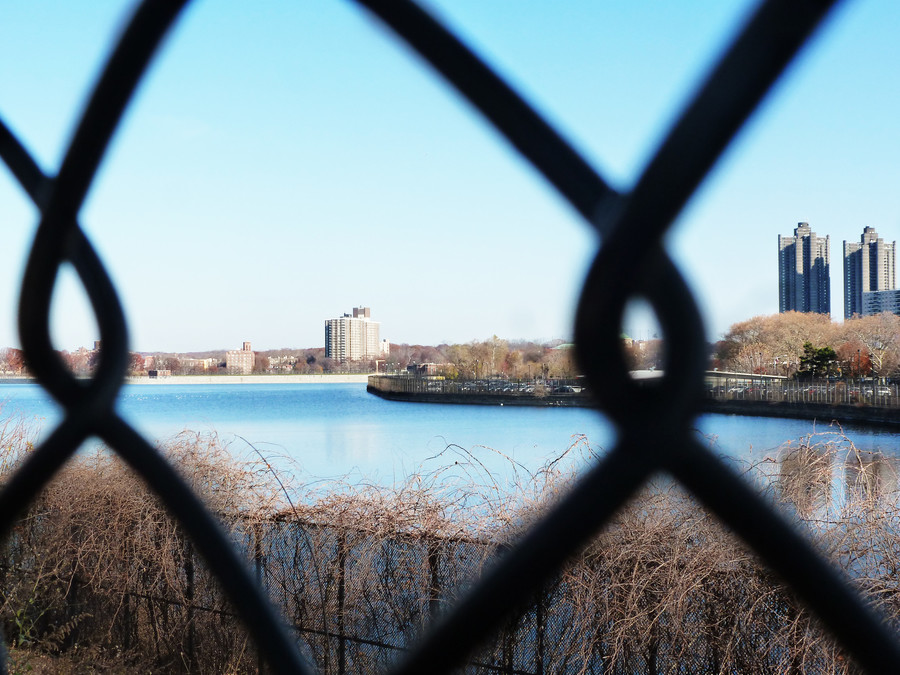Set the reservoir free
Editorial
At a turn in the road, where a side street merges into Reservoir Avenue, a blue expanse of water came into view on a recent day, framed by a line of trees and complete with a pair of swans bobbing on the waves.
A traveler from Europe, passing through the northwest Bronx, let out a gasp of admiration and turned to a Press journalist accompanying her on the tour: “What a view! Do you have a lake here? Or a river?”
No, not really. The waterway that stoked the European traveler’s admiration was Jerome Park Reservoir – a glorious body of water that glistens like an unexpected, and unexpectedly vast, freshwater lake in an urban setting.
Except that the reservoir is surrounded by two rows of fences, topped with security cameras.
If Jerome Park Reservoir is a lake, it is an imprisoned lake. It is there to be seen – or at least parts of it are, if you can find a good vantage point or are lucky enough to be living on a top floor of a nearby building facing the reservoir – but it is closed to the public. You cannot stroll along is shores. You cannot touch the water or let your kids splash in it. You certainly cannot feed the swans.
The swans, or other birds for that matter, have so far been the only visitors enjoying unhindered access to the reservoir, but even that is likely to change. The city’s Department of Environmental protection wants to string rows of bird-deterrent wires across the waterbody to prevent birds from landing on its surface.
The need for the bird wires, which no laws and no environmental or sanitation rules require, has been widely debated since the DEP proposed the wire installation in late November. But the fact that the plan is being debated is small consolation to those who oppose it: Proposals to open the reservoir for public access have also, similarly, been debated, but to no avail. City officials listened, or made a show of listening, and then persisted in doing what they had been doing for decades – keeping the reservoir locked up.
The possibility of giving the public unhindered access to the reservoir makes city officials nervous, and understandably so. In today’s New York, terrorism is not an abstract threat. Waterways can be poisoned. Consequences can be devastating. The city’s water-supply system needs to be protected.
But a sad fact of urban life is that nearly every aspect of it is potentially vulnerable, not just the waterways. Apartment buildings can be ravaged by gas explosions and even, occasionally, by a falling construction crane. Roads are hazardous with all the reckless drivers and, occasionally, the lack of traffic lights. The absence of a functioning traffic light contributed to a fatal collision on Broadway in Riverdale in late November, according to police. Airplanes have been known to crash, get hijacked or bombed. Subway systems around the world have been bombed, and so have popular athletic events. The list goes on.
Concerns of modern life are justifiable. Yet none of them have stopped New Yorkers from strolling in parks, running the marathon, riding the subway, walking on the streets, or enjoying a quiet evening at home – even if the home is in an older building with gas stoves. And none of the hazards have prompted city authorities to shut down the subway, close off parks, turn off gas supplies to apartment buildings, cancel marathons or outdoor concerts, and ban airlines from carrying members of the public on their flights.
We do not let terrorists dictate the way we live, because if we do so, terrorists have won.
Public access to a particular reservoir in the Bronx is a small matter in that regard. It concerns a single waterway amid the many lakes, ponds and streams in the city. Closing off a single reservoir is certainly not the same as closing off all city parks would have been. But it is part of the same pattern.
The city’s water-supply system needs to be safeguarded. As do subway trains, pedestrians on the street, airplanes, apartment buildings’ gas pipes – the list goes on. But there are better ways of safeguarding something than sealing it off, locking it up and surrounding it by a fence.
Members of the northwest Bronx community have urged the city repeatedly to allow some public access to the reservoir. The community has tried to negotiate, meet the authorities half-way, find a solution. Fences around the reservoir could stay in place, security checks could be conducted, guards could be employed, bags could be prohibited from the reservoir’s grounds, security cameras could continue recording everything that goes on around the waterway.
Allowing limited public access to the reservoir does not mean throwing all security precautions to the wind. But ways to allow some public access should be considered.
After all, the water of the reservoir flows from upstate streams – which are also vulnerable, like nearly every aspect of modern life. But that has not yet prompted attempts to close off natural waterways from public access. And after all, the reservoir’s water goes for purification into a nearby filtration plant before it reaches New Yorkers’ taps.






